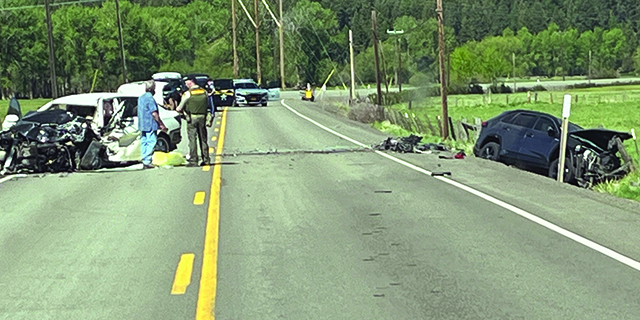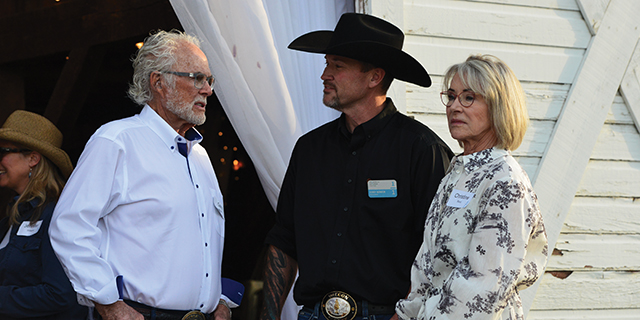Steve Amen and ‘Oregon Field Guide’: Telling the story of rural Oregon
Published 9:20 pm Friday, August 26, 2011

- Steve Amen, the host and executive producer of Oregon Field Guide, gives a presentation at Cook Memorial Library in La Grande on Sunday. DICK MASON / The Observer
Steve Amen of Oregon Public Broadcasting had an ambitious goal in the late 1980s – open up a statewide conversation.
Twenty-three years later that conversation, to Amen’s amazement, is continuing at full throttle.
Amen, who spoke in La Grande Sunday before a standing-room-only audience of about 150 at Cook Memorial Library, helped found “Oregon Field Guide” in the late 1980s. He has been its host and executive producer since then.
Amen said the idea for the show came to him while watching a documentary about the gulf between people in rural and urban Oregon. A rural Oregon man interviewed for the documentary complained about how city dwellers dictate what he can and cannot do.
“I’m sick and tired of having people who live on 50 by 100- foot lots tell me what I can do with my 20,000 acres,” the man said in the documentary.
This comment convinced Amen that something needed to be done to “open up a conversation” between rural and urban Oregon.
Amen, OFG’s executive producer, said he believed that urban residents would welcome such a program.
“People want to know and have a better understanding of the rural lifestyle,” Amen said.
“Oregon Field Guide,” which will start its 23rd season this fall, has helped start and keep this dialogue going, addressing issues ranging from wolves to wind power and endangered wildlife.
Amen said “Oregon Field Guide’s” staff strives to report on issues in such a way that the viewers can make up their own minds.
“We present both sides of an issue without mentioning our own bias. We never offer our opinion or take a position.”
This means “Oregon Field Guide’s” staff must find people on both sides of issues and talk about them.
“We want people to articulate a vision,” Amen said.
This can be difficult because some of the people best qualified to speak about a side of an issue let their feelings get in the way of expressing themselves.
“They are so emotional it gets in the way (of communicating),” Amen said.
La Grande was the last stop of an Eastern Oregon tour for Amen and the only one that had a standing-room-only audience.
“Clearly you guys want to be part of the discussion,” Amen said to his La Grande audience.
A highlight of Amen’s entertaining and fast-paced presentation was video highlights of past shows, often complete with behind-the-scenes information. They included footage of:
andbull; a little known waterfall in the Cascades, North Olalli Spring, so beautiful that the “Oregon Field Guide” staff had to promise the people who brought them to site not to reveal where the scenic wonder is to prevent crowds from coming.
andbull; people flying in gyrocopters. Amen told of how an “Oregon Field Guide” photographer was following them in a gyrocopter when his seat belt came off. The terrified photographer could not reach down to put the seat belt back on because he would have fallen off. The terrified photographer held on to his camera and continued filming.
andbull; Dynamite Hole on the Umpqua River, a site sometimes so thick with spawning steelhead that a man is assigned by the state to stay at the site day and night to prevent people from poaching the fish.
andbull; underwater kayaking in the Clackamas River. Individuals were shown paddling a squirt boat while completely submerged.
“I’m old school,” Amen said. “I think boats were meant to be above water.”
andbull; striking footage of bighorn sheep and mountain goats nimbly running up the rugged Wallowas.
andbull; footage of Spirit Lake near Mount. St. Helens, the volcano that blew in 1981. The lake is so nutrient-rich today that its trout grow twice the normal rate their first three years of life. Some believe the reason Spirit Lake is so nutrient-rich is that much of it is still covered by trees thrown into it during the 1981 eruption. The floating trees may be preventing nutrients from leaving the lake.
None of the video clips were shown to the accompaniment of music. This was not a coincidence since no music is played on “Oregon Field Guide.” Amen said he decided in year one that he wanted only the actual sounds of the sites while filming was done to be heard on the show. This adds to the authenticity of the program, said Amen, who believes music would cheapen it.
“We want viewers to hear birds, the wind, the sound walking on gravel. … We want to give them an experience that makes them feel like they are there.”
“Oregon Field Guide” produces 13 half-hour shows a year, each of which has three separate segments. It has a tight production schedule but enough leeway with deadlines that its crews can return to a site weeks or months later so they can provide a full picture to viewers in a single story.
Amen said this state is so diverse that “Oregon Field Guide” will never run short of program ideas.
“There are twice as many stories as we can do,” Amen said.
Still, he emphasized that everyone with ideas for future programs is encouraged to email them to OPB at membercenter@opb.org. Amen said tips are taken seriously and often lead to stories on “Oregon Field Guide.”
“We want you to help us tell the story of rural Oregon,” he said.





